7. May 2018 - 21:59
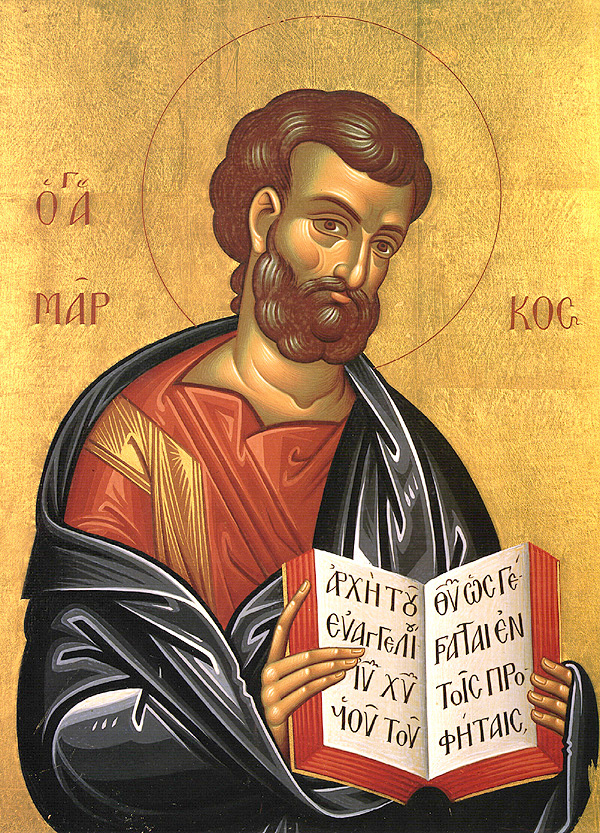 The Holy Apostle and Evangelist Mark, also known as John Mark (Acts 12:12), was one of the Seventy Apostles, and was also a nephew of Saint Barnabas (June 11). He was born at Jerusalem. The house of his mother Mary adjoined the Garden of Gethsemane. As Church Tradition relates, on the night that Christ was betrayed he followed after Him, wrapped only in a linen cloth. He was seized by soldiers, and fled away naked, leaving the cloth behind (Mark 14:51-52). After the Ascension of the Lord, the house of his mother Mary became a place where Christians gathered, and a place of lodging for some of the Apostles (Acts 12:12).
The Holy Apostle and Evangelist Mark, also known as John Mark (Acts 12:12), was one of the Seventy Apostles, and was also a nephew of Saint Barnabas (June 11). He was born at Jerusalem. The house of his mother Mary adjoined the Garden of Gethsemane. As Church Tradition relates, on the night that Christ was betrayed he followed after Him, wrapped only in a linen cloth. He was seized by soldiers, and fled away naked, leaving the cloth behind (Mark 14:51-52). After the Ascension of the Lord, the house of his mother Mary became a place where Christians gathered, and a place of lodging for some of the Apostles (Acts 12:12).
Saint Mark was a very close companion of the Apostles Peter and Paul (June 29) and Barnabas. Saint Mark was at Seleucia with Paul and Barnabas, and from there he set off to the island of Cyprus, and he traversed the whole of it from east to west. In the city of Paphos, Saint Mark witnessed the blinding of the sorcerer Elymas by Saint Paul (Acts 13:6-12).
3. May 2018 - 12:09
Today finds us at the exact midpoint of the sacred 50-day period between the Feasts of Pascha and Pentecost. So, this 25th day is called, simply, Midfeast or Mid-Pentecost. Pentecost (from the Greek pentecosti) is, of course, the name of the great Feast on the 50th day after Pascha, but the term is also used to cover the entire 50-day period linking the two feasts, thus expressing their profound inner unity. Our emphasis on the greatness of Pascha—the “Feast of Feasts”— may at times come at the expense of Pentecost, but in an essential manner Pascha is dependent upon Pentecost for its ultimate fulfillment. As Prof. Veselin Kesich wrote, “Because of Pentecost the resurrection of Christ is a present reality, not just an event that belongs to the past.” Metropolitan Kallistos Ware stated that “we do not say merely, ‘Christ rose,’ but ‘Christ is risen’—He lives now, for me and in me. This immediacy and personal directness in our relationship with Jesus is precisely the work of the Spirit. Any transformation of human life is testimony to the resurrection of Christ and the descent of the Spirit on the day of Pentecost. God constantly creates new things and glorifies Himself in His saints, in order to make it known that the Word of God became flesh, experiences death on the cross, and was raised up that we might receive the Spirit” (The First Day of the New Creation, p. 173).
7. April 2018 - 14:37
 The Holy Fire has descended in the Church of the Holy Sepulchre in Jerusalem, as seen on the live stream on the Facebook page of the Jerusalem Patriarchate and on RIA-Novosti.
The Holy Fire has descended in the Church of the Holy Sepulchre in Jerusalem, as seen on the live stream on the Facebook page of the Jerusalem Patriarchate and on RIA-Novosti.
The Holy Light descended at about 2:20 PM (7:20 AM Eastern Standard time).
The Holy Fire appeared in the edicule (the small chapel built over the burial place of Christ) just a few minutes after the Orthodox patriarch of Jerusalem, Theophilos III, entered there to patiently pray and wait. The edicule was newly-restored for the first time in centuries just in time for the Holy Fire service and Pascha last year, and was consecrated on March 22 last year after nine months of work.
25. March 2018 - 15:10
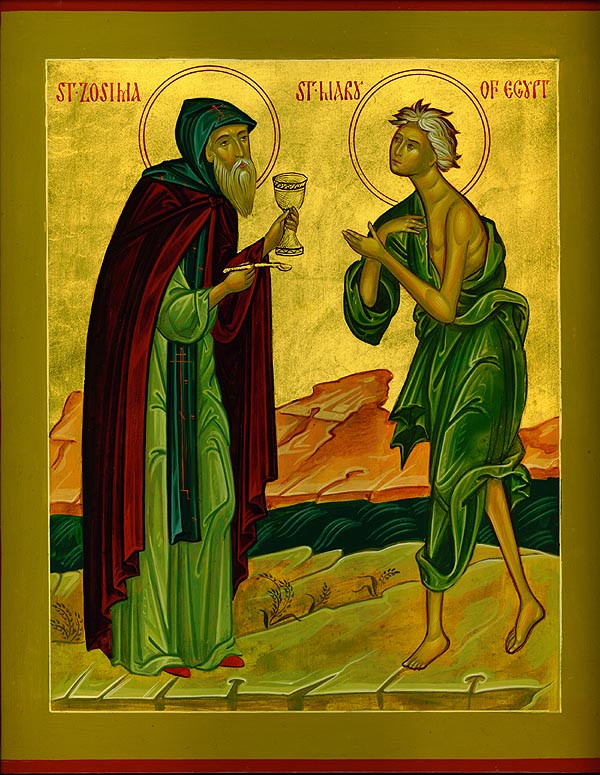 This Life of Our Venerable Mother Mary of Egypt was written down in the seventh century by Saint Sophronius, Patriarch of Jerusalem, some hundred years after the repose of the holy Mary, who fell asleep in the Lord April 1, 522. It is one of the most beautiful and edifying lives of a saint. Its obvious and stated purpose is to glorify God and to feed the souls of its readers. St. Sophronius lifts up the life of blessed Mary as a most wondrous example of repentance for all the faithful. Indeed, the Church has lifted up this life before all the faithful on the Fifth Sunday of the Great Fast, the Sunday before Palm Sunday. It is both a challenge and an inspiration to us. It shows us what a human being is capable of when she works with the all-powerful saving and forgiving grace of our all-loving God.
This Life of Our Venerable Mother Mary of Egypt was written down in the seventh century by Saint Sophronius, Patriarch of Jerusalem, some hundred years after the repose of the holy Mary, who fell asleep in the Lord April 1, 522. It is one of the most beautiful and edifying lives of a saint. Its obvious and stated purpose is to glorify God and to feed the souls of its readers. St. Sophronius lifts up the life of blessed Mary as a most wondrous example of repentance for all the faithful. Indeed, the Church has lifted up this life before all the faithful on the Fifth Sunday of the Great Fast, the Sunday before Palm Sunday. It is both a challenge and an inspiration to us. It shows us what a human being is capable of when she works with the all-powerful saving and forgiving grace of our all-loving God.
6. March 2018 - 10:58
 The Sunday of the Paralytic
The Sunday of the Paralytic
By practicing Christian virtues we are trying to have a Christ-like life and to direct ourselves to God. Above anything else, lent is an exercise in overcoming all the obstacles in order to come before the Physician of our souls and bodies – Jesus Christ. Today’s Gospel teaches directly to this important point. This Bible story is about people’s faith and their effort to cross all the barriers to be in front of Christ.
 The Sunday of the Paralytic
The Sunday of the Paralytic
 The Holy Apostle and Evangelist Mark, also known as John Mark (Acts 12:12), was one of the Seventy Apostles, and was also a nephew of Saint Barnabas (June 11). He was born at Jerusalem. The house of his mother Mary adjoined the Garden of Gethsemane. As Church Tradition relates, on the night that Christ was betrayed he followed after Him, wrapped only in a linen cloth. He was seized by soldiers, and fled away naked, leaving the cloth behind (Mark 14:51-52). After the Ascension of the Lord, the house of his mother Mary became a place where Christians gathered, and a place of lodging for some of the Apostles (Acts 12:12).
The Holy Apostle and Evangelist Mark, also known as John Mark (Acts 12:12), was one of the Seventy Apostles, and was also a nephew of Saint Barnabas (June 11). He was born at Jerusalem. The house of his mother Mary adjoined the Garden of Gethsemane. As Church Tradition relates, on the night that Christ was betrayed he followed after Him, wrapped only in a linen cloth. He was seized by soldiers, and fled away naked, leaving the cloth behind (Mark 14:51-52). After the Ascension of the Lord, the house of his mother Mary became a place where Christians gathered, and a place of lodging for some of the Apostles (Acts 12:12). The Holy Fire has descended in the Church of the Holy Sepulchre in Jerusalem, as seen on the live stream on the Facebook page of the Jerusalem Patriarchate and on RIA-Novosti.
The Holy Fire has descended in the Church of the Holy Sepulchre in Jerusalem, as seen on the live stream on the Facebook page of the Jerusalem Patriarchate and on RIA-Novosti.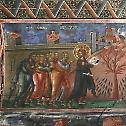

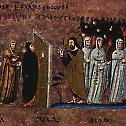
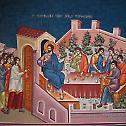
 This Life of Our Venerable Mother Mary of Egypt was written down in the seventh century by Saint Sophronius, Patriarch of Jerusalem, some hundred years after the repose of the holy Mary, who fell asleep in the Lord April 1, 522. It is one of the most beautiful and edifying lives of a saint. Its obvious and stated purpose is to glorify God and to feed the souls of its readers. St. Sophronius lifts up the life of blessed Mary as a most wondrous example of repentance for all the faithful. Indeed, the Church has lifted up this life before all the faithful on the Fifth Sunday of the Great Fast, the Sunday before Palm Sunday. It is both a challenge and an inspiration to us. It shows us what a human being is capable of when she works with the all-powerful saving and forgiving grace of our all-loving God.
This Life of Our Venerable Mother Mary of Egypt was written down in the seventh century by Saint Sophronius, Patriarch of Jerusalem, some hundred years after the repose of the holy Mary, who fell asleep in the Lord April 1, 522. It is one of the most beautiful and edifying lives of a saint. Its obvious and stated purpose is to glorify God and to feed the souls of its readers. St. Sophronius lifts up the life of blessed Mary as a most wondrous example of repentance for all the faithful. Indeed, the Church has lifted up this life before all the faithful on the Fifth Sunday of the Great Fast, the Sunday before Palm Sunday. It is both a challenge and an inspiration to us. It shows us what a human being is capable of when she works with the all-powerful saving and forgiving grace of our all-loving God.